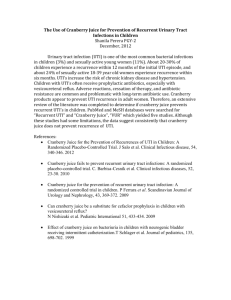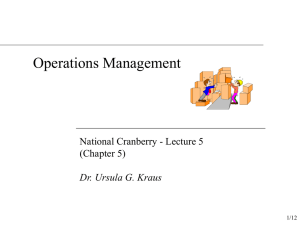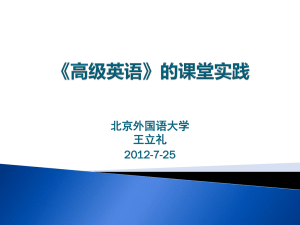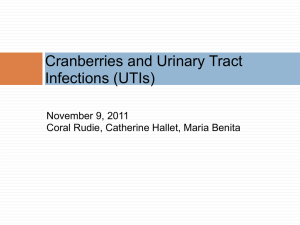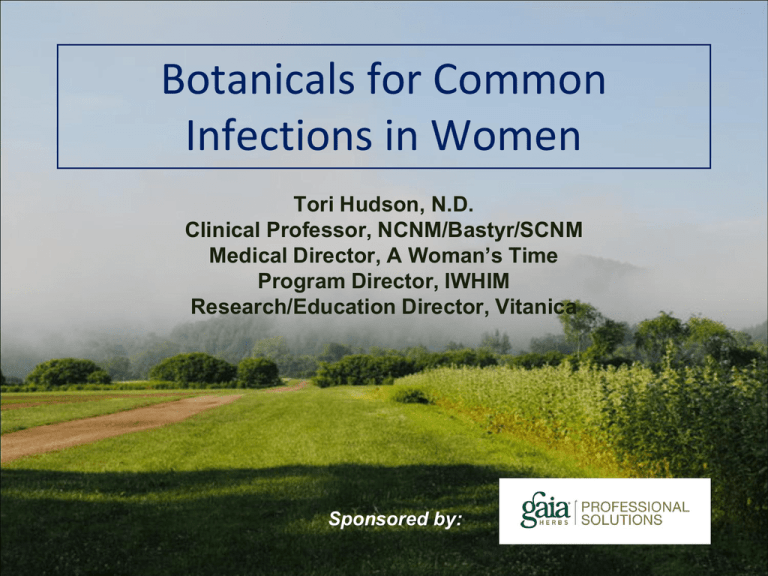
Botanicals for Common
Infections in Women
Tori Hudson, N.D.
Clinical Professor, NCNM/Bastyr/SCNM
Medical Director, A Woman’s Time
Program Director, IWHIM
Research/Education Director, Vitanica
Sponsored by:
Disclosures
• Vitanica: Director Education/Research;
Co-owner
• Scientific Advisory Boards
Gaia Herbs
Nordic Naturals
Integrative Therapeutics Inc
Natural Health International
To Be Discussed
•
•
•
•
•
Yeast vaginitis
Bacterial vaginosis
Cystitis
HPV
Genital herpes
Garlic/thyme cream for YVV
N= 64; ages 30-37
• 32 women = vaginal cream containing garlic and thyme or 32 women =
vaginal cream with clotrimazole cream for 7 nights.
• The therapeutic response was considered successful if there was an
absence of Candida hyphae microscopically and a negative culture for
Candida.
• The authors report significant improvement in clinical symptoms in both
groups after treatment (P<0.05). The garlic/thyme group reported a greater
decrease in vulva erythema compared with the clotrimazole group (P=0.02).
No worsening of symptoms was reported in either group.
• Of the adverse side effects reported, "other side effects" were seen in 9.4%
of the clotrimazole group and in 34.4% of the garlic/thyme group.
Iran J Nurs Midwifery Res. December 2010;15(suppl 1):343-349.
Yeast Vaginitis - Additional vaginal agents
• Berberine (goldenseal,oregon grape) - in vitro antifungal;
candida albicans.
• Calendula - historical use as a local/topical remedy for
local infections, wounds, injuries.
• Garlic - in vitro inhibitor of candida albicans.
• Tea tree - in vitro; inhibitor of candida albicans.
• Homeopathics (OTC criteria) – Borax, Hydrastis,
Berberis, Kreosotum,others.
• Povidine iodine - paint cervix and vagina with solution on
day one. Applicator gel (5gm) bedtime, douche next
morning using 2T/1qt water bid x 6.
Calif Med 1969;110
Lactobacillus species/strains
antipathogen properties
•
•
•
•
•
•
•
L rhamnosus GG
L acidophilus NCFM
L casei Shirota
L. reuteri MM 53
L. casei CRL-431
L. rhamnosus GR-1
L fermentum RC-14
Others to consider:
• L plantarum 299V
• L salivarius
Candida Vaginitis
Sample Treatment Plan
• Acute
- Boric acid suppositories bid X 3-7 days
- Yogurt 8oz daily and/or Lactobacillus
species/strains combinations for 2 weeks
• Chronic
- Boric acid suppositories bid x 2-4 wks; then
prophylactic plan
- Yogurt 8oz daily and/or Lactobacillus
species/strains combinations for 2-6 mo.
- Consider systemic: Garlic, Oregon grape,
Goldenseal
Bacterial Vaginosis
• Allium sativum (Garlic)
- Effective against some antibiotic resistant
organisms
- Allicin: growth – inhibitory constituent
Bacterial Vaginosis – Additional Botanicals
• Contain berberine: antibacterial; specific for mucosal
surfaces
Goldenseal (Hydrastic canadensis)
Oregon grape (Berberis vulgaris)
• Tea tree (Malaleuca alternifolia)
antibacterial and antifungal
daily douching effective in candidiasis, trichomoniasis
and cervicitis
BV and Vitamin C
• 250 mg vitamin C vaginally for six days
Vit C
placebo
• No clue cells
79%
53%
• No bacteria
77%
54%
• L. reappeared
79.1%
53.3%
• pH > 4.7
16.3%
38.6%
• BV persisted
14%
35.7%
Eur J Ob/GYN 2004
Bacterial Vaginosis
Other agents:
• Topical 5% aqueous propolis solution
• Topical Povidone-iodine
• Ascorbic acid suppositories
• Additional agents - Homeopathics:
– Borax, Hydrastis Canadensis, Kreosotum, Sepia,
Calcarea Carbonicum, Nitric acidum, Carbolic
acidum
Lactobacillus species/strains
antipathogen properties
•
•
•
•
•
•
•
L rhamnosus GG
L acidophilus NCFM
L casei Shirota
L. reuteri MM 53
L. casei CRL-431
L. rhamnosus GR-1
L fermentum RC-14
Others to consider:
• L plantarum 299V
• L salivarius
Bacterial Vaginosis
Sample Treatment Plan
Option A
• Vitamin C tablet x 6 days then
• Boric acid supp 1/day x 1 week
• Lactobacillus species/strains x 4 weeks
• Systemic immune support:
– Oregon grape, Goldenseal; 1 tsp bid
Bacterial Vaginosis
Sample Treatment Plan
Option B
• Metronidazole gel - 1 gm bid x 5-10 days
• Concurrent oral lactobacillus species/strains 8+billion or
more daily for 2-4 weeks
• Follow metronidazole with lactobacillus suppositories
1x/day for 7-14 days plus boric acid supp 1/day for 7-14
days
• Systemic immune support = Oregon grape, garlic,
goldenseal
• Immune supportive diet
UTI: Cranberry
• 20 adults who did not have an active urinary tract infection, and
were not taking antibiotics.
• In phase 1: 3 caps that contained 275 mg of a mixture of dried whole
cranberry extract and 25 mg of a concentrate of cranberry extract.
• In phase 2: no cranberry on day 1 and 900 mg of cranberry
preparation on day two.
• Results: In phase 1, 7 of 20 (35%) individuals had anti-microbial
activity against Escherichia coli,13 of 20 (65%) had anti-microbial
activity against Klebsiella pneumoniae, and 9 of 20 (45%) against
Candida albicans.
• In phase 2, 23% showed antimicrobial activity against E. coli, 33%
against C. albicans, and 67% against K. pneumoniae.
eCAM 2010;7(2):227-232 doi:10.1093/ecam/nem183
UTI: Cranberry
• 10 Greek postmenopausal women who had at least 3 documented
urinary tract infections (UTIs) in the previous year or at least 2 UTIs
in the last 6 months prior to the start of the study.
• 400 mg of cranberry extract twice per day over 6 months.
• While taking the cranberry extract, none of the women had a UTI
over the course of the 6 months and almost all of the urine cultures
were sterile (normal). Three women reported mild gastrointestinal
problems and their dose was reduced to 2 capsules per day and as
a result, their gastrointestinal problems subsided.
J Altern Complement Med 2009;15(11):1155.
UTI: Uva ursi
• Arctostaphylos uva ursi
• Constituents:
– Arbutin
• Action:
– Antiseptic; most effective in alkaline environment
• Dose:
– Freeze-dried leaves = 500-1000 mg per day
– Tincture = 1-1.5 tsp tid
– CI during pregnancy
UTI: Uva ursi
• Also contains:
–
–
–
–
–
–
methylarbutin
tannins
ursolic acid (diuretic)
phenolic acid
resins
flavonoids(quercitin and Isoquercitin)
UTI: Goldenseal
• Hydrastis canadensis
• Constituent:
– Berberine
• Action:
– Antibacterial
– Inhibits bacteria from adhering
• Dose:
– Freeze-dried = 500-1000 mg tid
– Tincture = 1-1/2 tsp tid
UTI: Oregon Grape
• Berberis aquifolium
• Constituent:
– Berberine
• Action:
– Antibacterial
– Inhibits bacteria from adhering
UTI: Pipsissewa
• Chimaphila umbellata
• Constituents:
– Arbutin
• Action:
–
–
–
–
–
Antiseptic
Antibacterial
Astringent
Alterative
Diuretic
UTI: Marshmallow
• Althaea officinalis
• Constituents:
– Mucilage
• Action:
– Protective layer
UTI: Buchu
• Barosma betulina
• Constituents:
– Flavonoids
– Mucilageous constituents
• Action:
– Diuretic; protective layer
• Dose:
– 500-1000 mg tid
– tincture 1 ½ tsp tid
Cystitis: Sample Treatment Plan - Acute
• Increase water (8 or more glasses daily)
• Increase cranberry juice (16 oz daily)
• Vitamin C (2,000 mg every 2 hours for 2 days,
then 2 grams tid for one week)
• Botanicals: cranberry, goldenseal, Oregon grape
root, buchu, uva ursi, pipsissewa (every 2 hours
for 2 days, then 2 doses tid for one week)
Formula, singles or similar formula
Cystitis: Sample Treatment Plan
Chronic recurring
•
•
•
•
•
•
•
Void upon urge, after intercourse
Condoms if intercourse
Staphysagria after intercourse
Increase fluids
Cranberry extract 400 mg bid
Mannose powder 1 tsp/day
Probiotics–8+ billion daily; urogenital specific
species (consider intravaginal lactobacillus spp)
HPV Treatment
• Treating HPV-infected cells may help
boost immunity by destroying the cells
within which the HPV resides, thereby
releasing HPV to disease-fighting dendritic
cells and macrophages.
Naturopathic Treatment
•
•
•
•
•
Smoking cessation
Safe sex practice education
Support the immune system
Treat HPV
Treat the dysplasia
Three Month Oral Protocol
• Botanical Protocol 1
–
–
–
–
Red clover
Dandelion root
Licorice root
Goldenseal root
• Botanical Protocol 2
–
–
–
–
Thuja
Echinacea
Goldenseal root
Ligusticum
Cervical Dysplasia Research
• Green tea
• Coriolus versicolor
• I3C/DIM
Cervical Dysplasia Green Tea Vaginal and Oral
• 51 patients with cervicitis to CIN 2 divided into 4 groups and
compared to 39 controls.
–
–
–
–
20/27 using poly E ointment vaginally 2x/week
6/8 poly E plus poly E capsule
3/6 poly E capsule
6/10 EGCG capsule
• Overall: 69% response rate 35/51 with green tea extract vs 10 %
response rate 4/39 in controls (P<0.05).
Eur j cancer prev 2003;12(5):383-390
Green Tea
• ECGC in green tea was evaluated on cervical
epithelial; cells and cervical cancer cells and
HPV.
• Both ECGC and polyphenols E inhibited
immortalized cervical epithelial and cancer
cell growth.
• Green tea induced apoptosis, decreased
gene expression, and cell cycle changes.
Int J Gynecol Cancer. 2010 ;20(4):617-624
Green tea ointment and anogenital warts
• RCT
• Sinecatechins ointment 15% or 10% or
placebo three times daily for a maximum
of 16 weeks or until complete clearance of
all warts, followed by a 12 week tx free f/u
to assess recurrence.
Tatti S, et al. Ob and Gyn2008;111(6):1371
Green tea and warts
• Two phase III trials evaluated treatment of
EGWs with ointment containing a mixture of
green tea catechins (Polyphenon E), U.S.
adopted name: sinecatechins.
• Men and women aged > 18 years with two to
30 EGWs applied vehicle Polyphenon E
ointment 10% or Polyphenon E ointment 15%
three times daily until complete clearance of
all EGWs (baseline + new EGWs) or for a
maximum of 16 weeks.
• 838 completed treatment after 16 weeks.
Green Tea and warts con’t
• Complete clearance of all EGWs was
obtained in 53.6% (10% ointment) and
54.9% (15% ointment) of patients with
Polyphenon E vs. vehicle.
• Statistically significant differences in
clearance rates appeared after 6 weeks of
active treatment.
• Only a 55 recurrence rate.
Br J Dermatol. 2010 Jan;162(1):176-84.
Additional Anti-viral herbs
HPV and CIN
• Consider; Mahonia, licorice, thuja,
melissa, hypericum, echinacea
Coriolus versicolor
•
•
•
•
39 patients with biopsy confirmed LSIL
21 were controlled
18 took coriolus 3grams/day for 1yr
72.5% of the 18 patients who took coriolus
showed normal cervical cytology
• 90% of patients with HPV+ high risk and
took coriolus reverted to HPV negative
Couto. S. Clinical Journal of Mycology. January 2012 Volume 3
Indole-3-carbinol
• 30 patients with CIN II-III
• 17 took I-3-C 400mg for 12 weeks (13
placebo group)
• 8 of the 17 had complete regression
• I-3-C up-regulates tumor suppressor gene
PTEN which is MOA for inhibiting
development of cervical cancer.
Gynecol Oncol 2000. 7(2) 123-129
Original research results for treating
ASCUS, CIN, CIS
• 43 cases, including cervical atypia (n=7),
cervical dysplasia (n=26), and carcinoma
in situ (n=10)
• 43 patients:
- 38 = normal
- 3 = partial improvements
- 2 = no change
- 0 = no one worse
Genital Herpes
Natural Treatment Interventions
• Considerations
- Host health
- Prevention of recurrences
- Immune support
- Reduce triggers
- Mucosal immunity
- Anti-viral therapies
Botanicals - Topical Lemon Balm
• Recurrent Oral; n=66
• 10% S.E. lemon balm vs placebo qid x 5 d
• Applied cream no more than 4 hours after
onset of prodrome.
• Results: day 2 = reduction in severity and
number of eruptions with lemon balm.
• Total score over 5 days = no difference.
(Koytchev et al)
Larrea Tridentata
• Larrea leaf resin inhibits HSV-2 replication
- NDGA (nordihydroguaiaretic acid)
- mal.4
• Acts to inhibit the activity of a gene promotor that
is important for viral replication
• Use: Leaf resin capsules 1-2 daily; topical
Larrea lotion
Propolis vs. Acyclovir for Genital Herpes
• N=46 men and 44 women, 18–69 y.o.
• Recurrent chronic genital HSV type 2
• Tx: 3% propolis ointment
5% Acyclovir ointment
Placebo
qid for 10 days
Phytomedicine 2000;7(1)
Propolis vs. Acyclovir for Genital Herpes
Day
3 (crusts)
Propolis
50%
Acyclovir
27%
Placebo
0%
7 (Ulcers/
Healed)
55%
26%
30%
10 (ulcers/
Healed)
100%
80%
70%
Dr. Hudson Resources
• Women’s Encyclopedia of Natural Medicine; 2nd
Edition 2008; Hudson; McGraw-Hill
•
•
•
•
www.drtorihudson.com
www.instituteofwomenshealth.com
www.awomanstime.com
womanstime@aol.com
Webinar sponsored by:
Webinar sponsored by:
Pictured: Gaia Herbs Farm, Brevard NC
Pictured: Gaia Herbs Farm, Brevard NC

